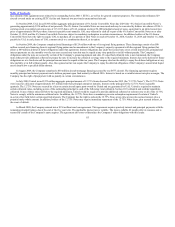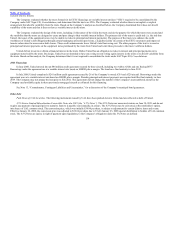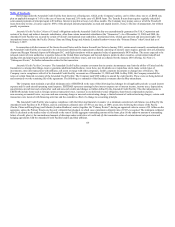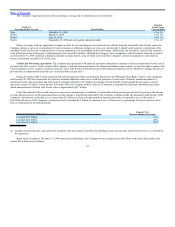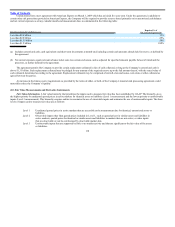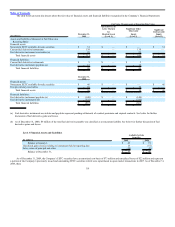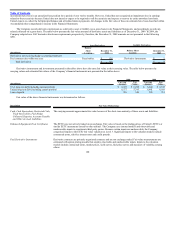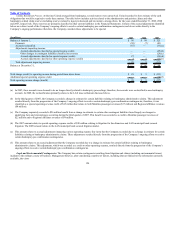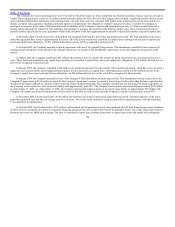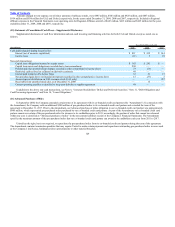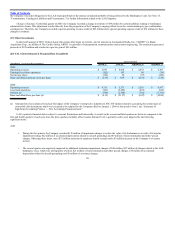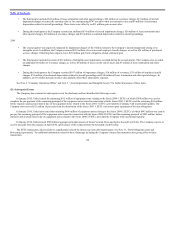United Airlines 2009 Annual Report Download - page 126
Download and view the complete annual report
Please find page 126 of the 2009 United Airlines annual report below. You can navigate through the pages in the report by either clicking on the pages listed below, or by using the keyword search tool below to find specific information within the annual report.
Table of Contents
United when the price of the underlying commodity is above (below) the price specified in the swap agreement. Generally, the Company’s hedge instruments are
based on crude oil, heating oil or jet fuel. As of December 31, 2009, the Company’s hedge positions were primarily based on either heating oil or jet fuel.
The following table presents the fuel hedge (gains) losses recognized during the periods presented and their classification in the Financial Statements. Fuel
hedge gains (losses) are not allocated to Regional Affiliates expense.
Mainline Fuel
Nonoperating Income
(Expense) Total
Year Ended December 31, Year Ended December 31, Year Ended December 31,
(In millions) 2009 2008 2007 2009 2008 2007 2009 2008 2007
Cash fuel hedge (gains) losses $ 482 $ 40 $ (63) $ 248 $ 249 $ — $ 730 $ 289 $ (63)
Non-cash fuel hedge (gains) losses (586) 568 (20) (279) 279 — (865) 847 (20)
Total fuel hedge (gains) losses $ (104) $ 608 $ (83) $ (31) $ 528 $ — $ (135) $ 1,136 $ (83)
As of December 31, 2009, the Company had hedged approximately 36% of its 2010 consolidated fuel consumption primarily with a combination of swaps
and purchased call options. The Company’s hedge position at December 31, 2009 consisted of a notional amount of 9.7 million barrels with purchased call
options at a weighted-average crude oil equivalent strike price of $76 per barrel and 9.9 million barrels with swaps at a crude oil equivalent average price of $77
per barrel.
Foreign Currency Derivatives
The Company generates revenues and incurs expenses in numerous foreign currencies. Such expenses include fuel, aircraft leases, commissions, catering,
personnel expense, advertising and distribution costs, customer service expense and aircraft maintenance. Changes in foreign currency exchange rates impact the
Company’s results of operations and cash flows through changes in the dollar value of foreign currency-denominated operating revenues and expenses. When
management believes risk reduction can be effectively achieved, the Company may use foreign currency forward contracts to hedge a portion of its exposure to
changes in foreign currency exchange rates. The Company does not enter into foreign currency derivative contracts for purposes other than risk management. As
of December 31, 2009, the Company did not have any foreign currency derivatives. Hedge gains (losses) were not significant in any of the periods presented in
these Financial Statements. Foreign currency derivative gains and losses are classified in nonoperating expense in the Company’s Financial Statements.
Fair Value of Nonfinancial Assets
The table below presents disclosures about fair value measurements of nonfinancial assets that were performed during 2009. The fair values as of the
measurement dates are as follows:
(In millions)
Significant
Unobservable
Inputs
(Level 3)
Total
Gains/(Losses)
(Level 3)
Nonfinancial Assets Measured at Fair Value on a Nonrecurring Basis:
Nonoperating aircraft and spare engines $ 310 $ (93)
Tradenames 420 (150)
See Note 3, “Asset Impairments and Intangible Assets,” for a discussion of the factors warranting fair value assessment of the above assets. The Company
utilized a market approach to estimate the fair value of the aircraft.
122



